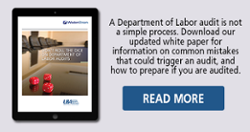By Bill Olson
Chief Marketing Officer at United Benefit Advisors
 Not many things incite more fear than receiving a notice that you’re about to have an audit, especially from the Department of Labor (DOL). The DOL is a cabinet-level department of the U.S. federal government responsible for occupational safety, wage and hour standards, unemployment insurance benefits, re-employment services, and some economic statistics. It is headed by the U.S. Secretary of Labor.
Not many things incite more fear than receiving a notice that you’re about to have an audit, especially from the Department of Labor (DOL). The DOL is a cabinet-level department of the U.S. federal government responsible for occupational safety, wage and hour standards, unemployment insurance benefits, re-employment services, and some economic statistics. It is headed by the U.S. Secretary of Labor.
What can trigger a DOL audit? Usually it’s one of two things — either a complaint, which leads to an investigation, or it’s totally random. While a DOL audit may or may not be triggered by the following, there are certain ways in which employers expose themselves to unnecessary risks:
- Not submitting Form 5500 reports on time if they have 100 or more participants
- Not having Summary Plan Descriptions (SPDs) for each Employee Retirement Income Security Act (ERISA) covered benefit or not using an SPD wrap document. Read more on the perils of neglecting written policies and procedures.
- Not completing all the various annual employee notifications such as Medicare Part D, Children’s Health Insurance Program (CHIP), Mental Health Parity Act (MHPA), Newborns’ and Mothers’ Health Protection Act (NMHPA), Women’s Health and Cancer Rights Act (WHCRA), Patient Protection and Affordable Care Act (ACA), Health Insurance Portability and Accountability Act (HIPAA), Health Exchange, etc.
- Not generating Summary of Material Modification (SMM) whenever there are material changes to benefits and then not saving these SMMs for future reference
- Not keeping Section 125 Premium Only Plan (POP) and flexible spending account (FSA) documents current and accurate
- Not filing Form 1095/1094 reports in a timely fashion, or if having conflicting information on these reports
- Not properly following the controlled group rules for owners of multiple organizations
Audit-proof your company with UBA’s latest white paper: Don’t Roll the Dice on Department of Labor Audits. This free resource offers valuable information about how to prepare for an audit, the best way to acclimate staff to the audit process, what the DOL wants, and the most important elements of complying with requests.
